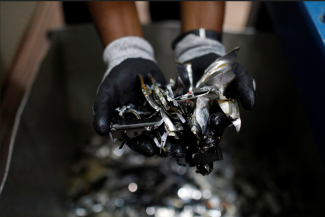Myanmar was already moving to get its businesses online. With COVID-19, they were able to speed things up.
It’s 2020 and online food delivery is booming. Whether Jakarta, New York or London, by motorbike, van or bicycle, this sector of ecommerce is definitely seeing a shift.
In Yangon, where citizens only got affordable and reliable internet a few years ago, there are now companies jostling in the sphere, vying for kyat spent on freshly made noodles, on groceries, on household goods and more.
“You can see it. My family buys online every day, and I try to buy my food online. Ecommerce is dramatically increasing in these last five or six months. If you’re on the road especially in Yangon there are so many food delivery and parcel delivery men. Everywhere,” said Su Thet Hninn.
But Su is not only a consumer, she also works at Myanmar’s Department of Trade as Assistant Director, and is its ecommerce focal point.
The country had already been working to support the ecommerce evolution there, and when COVID-19 started causing lockdowns and people started staying at home, Myanmar’s trade actors like Su and colleagues at the Ministry of Commerce shifted their strategy.
“Starting in March this year almost all our project activities stopped for two months, but at the end of April we adapted, starting online activities like webinars looking at how to mitigate the effects of COVID. Some activities we changed and tried to adapt to the situation. We developed a COVID-19 Economic Recovery Plan launched by the Government in May that included five specific action plans for ecommerce, and we started working with vendors to transform from offline to online,” Su said.
Ready
Myanmar’s efforts in the sector can be traced back to its 2018 Rapid eTrade Readiness Assessment, a kind of study that takes a frank look at the current situation in a country and the opportunities and barriers, produced by UNCTAD with the support of the Swedish Government and launched nationwide with the support of the Enhanced Integrated Framework (EIF).
“A lot has happened in Myanmar on ecommerce, both from the policy and regulatory side but also from a business development perspective. I think it has a lot to do with the eTrade Readiness Assessment – the beauty of it is that it takes different policy areas together and puts that into one single document and the country can compare itself to others that have undergone the same kind of assessment,” said Sven Callebaut, Digital Trade Policy Adviser to the Department of Trade and author of the study.
“The Ministry of Commerce was really willing to take the lead and that is not an easy thing because there are different ministries involved and they found a niche for themselves and found people in the Department of Trade interested in the topic and who understood that this work would have a big impact on what the sector would look like three years down the road,” Callebaut said.
With a population of 54 million and 22 million internet users, and 6.6% annual growth in those users, the country’s digital transformation is now very underway, alongside increasing demand for online services.
Set
With the recommendations from the study in place, the Department of Trade has been working with ministries, the private sector, UN agencies and development partners at various levels and via various approaches. The Department is producing Ecommerce Guidelines for Ecommerce Operators; an Ecommerce Strategy, funded by EIF and being developed following discussions with more than 400 people, is slated for release this December. And, an Ecommerce Law is in the drafting stage, in cooperation with the Ministry of Transport and Communication.
“Now after almost two years there has been so much progress, and trust from the private sector and the public is increasing,” Su said.
From online banking to ridesharing to marketplaces, companies from the entire ecommerce ecosystem have been emerging quickly in Myanmar. And, representatives from these companies were invited to explain how ecommerce is actually working to government officials.
Su said, “We had food delivery companies and the ecommerce payment providers – and other players – explain how they work. Even as regulators ourselves it was hard to see the whole picture of these ecommerce transactions. So we arranged the specific training for regulators.”
There was also a recent seven-week training on ecommerce for government officials, with those in the sector and practitioners breaking down the elements of the industry.
Funded by the Australian Department of Foreign Affairs and Trade (DFAT) and implemented by the Economic Research Institute for ASEAN and East Asia (ERIA), 11 different government departments were involved, with 25 ecommerce ‘students’ following a course divided into three broad areas of focus.
“We started with an intro – as ecommerce is not the same as traditional commerce – so covering what is b2b, what is a marketplace, what are digital payments. The second module covered the legal and regulatory framework for ecommerce and how to amend so as to ensure the sector develops sustainably, so things like consumer protection, online IPs, cybercrime, server localisation. And the third is what is happening in the international and regional organisations, so elements related to negotiations, development partner support, taxation of digital services,” said Callebaut, who led the training.
Go
Armed with research and knowledge and tools, the country was able to make quick shifts as the pandemic struck to help businesses go online.
“In May 2020 we started preparing what we call Good Practice Guides with TradeWorthy, a DFAT grantee, for moving businesses from offline to online during the pandemic, and are now working on the ecommerce registration systems. We don’t have this system right now and the businesses are fragmented with different types of licenses. And in the future we want to incentivise startups so we need to do the registration system and the business are asking for it,” Su said.
The Good Practice Guides were done in consultation with 10 of the leading industry players in Myanmar, and deal with consumer goods, food service, groceries, transportation and travel.
“The Guides describe what needs to be done, so getting your inventory in order, this is the software you need, and this is how you have to deal with the pandemic so best practices on contactless delivery, digital payments – all these sorts of things people are asking for because they want to move online and they don’t know how to do so,” said Su.
Since the pandemic struck, Myanmar has seen its digital sector flourish, from demand for broadband at home, where mobile has led the way, to delivery services.
As for what’s next, aside from continuing to support small businesses make the digital transition and the larger policy frameworks?
“The next challenge is cross border ecommerce, and for businesses to see the opportunities available outside the country, which is a way to diversify the economy. How do we make sure products and hopefully one day services can be sold overseas? Myanmar has a huge diaspora in Thailand and Singapore that want products from their home country, how do we deliver to them?” said Callebaut.
If you would like to reuse any material published here, please let us know by sending an email to EIF Communications: eifcommunications@wto.org.


